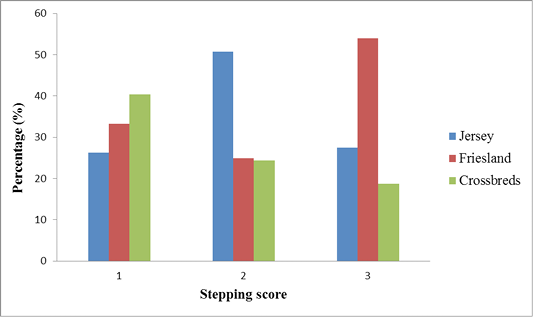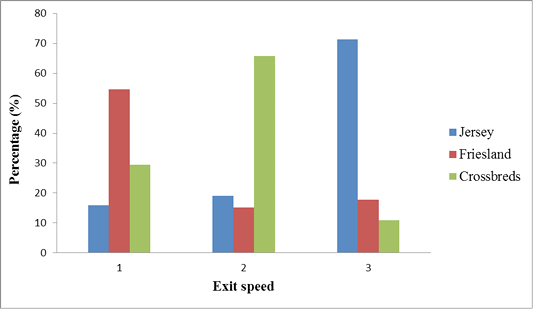Journal of Animal Health and Production
Research Article
Avoidance Behaviour of First Lactating Cows in a Pasture-based Dairy System in South Africa
Zuko Mpisana1, Ishmael Festus Jaja1,2*, James Oguttu2, Voster Muchenje1
1Department of Livestock and Pasture Science, University of Fort Hare, Private Bag X 1314, Alice, Eastern Cape, South Africa; 2Department of Agriculture and Animal Health, University of South Africa, Florida campus, Johannesburg 1709, South Africa.
Abstract | This study aimed to determine the avoidance behaviour of first lactating cows and its effect on milk yield in a pasture-based dairy system. The behavioural response of first lactating Jersey, Friesland and crossbred (Jersey x Friesland) cows to a new environment and human presence were determined by recording their avoidance distance scores (ADS), entrance scores (ENS), feeding scores (FS), the occurrence of stepping (STP), kicking (KCK) and exit speed (ES) for 80 consecutive days during the afternoon milking session from 14h00 to 17h00. Crossbred cows (78.7%) had the longest ADS (P < 0.05) compared to other genotypes, (Jersey 18.3%, and Friesland 3%). The Jersey cows had the highest (P < 0.05) ES compared to other genotypes. The Friesland cows had the highest (P < 0.05) daily milk yield compared to Jersey and crossbred cows. The primiparous cows of different breeds responded differently to an unfamiliar environment and humans.
Keywords | Behaviour, Exit speed, Feeding score, Genotype, Milking parlour, Primiparous
Editor | Asghar Ali Kamboh, Sindh Agriculture University, Tandojam, Pakistan.
Received | April 10, 2021; Accepted | June 24, 2021; Published | July 15, 2021
*Correspondence | Ishmael Festus Jaja, Department of Livestock and Pasture Science, University of Fort Hare, Private Bag X 1314, Alice, Eastern Cape, South Africa; Email: ijaja@ufh.ac.za
Citation | Mpisana Z, Jaja IF, Oguttu J, Muchenje V (2021). Avoidance behaviour of first lactating cows in a pasture-based dairy system in South Africa. J. Anim. Health Prod. 9(3): 277-284.
DOI | http://dx.doi.org/10.17852/journal.jahp/2021/9.3.277.284
ISSN | 2308-2801
Copyright © 2021 Mpisana et al. This is an open access article distributed under the Creative Commons Attribution License, which permits unrestricted use, distribution, and reproduction in any medium, provided the original work is properly cited.
INTRODUCTION
The human animal relationship is of paramount importance for the economic success of dairy production and welfare of dairy cows. This relationship involves fetching and handling of animals during farm activities such as milking, artificial insemination, routine vaccinations and screening for diseases (Waiblinger et al., 2006; Dodzi and Muchenje, 2011; Ndou et al., 2011). Handling of dairy cows, especially in a non-aversive manner, can increase daily milk production and improve welfare. In contrast, aversively handled cows tend to be uncomfortable and become frightened of humans. This increases hormonal stress and affects normal cow behaviour and reduces daily milk production. Animals may even become difficult to handle and aggressive to handlers and may even injure themselves (Waiblinger et al., 2006; Hemsworth et al., 2011).
Recent reviews on handling farm animals such as dairy and beef cattle, poultry and pigs indicate that aversive or rough handling increases fear and stress and negatively affects growth rate, feed conversion rate, production and health (Rutten et al., 2013). These affect biological functioning (Gibbons et al., 2012). In a pasture-based dairy system, primiparous and multiparous cows are allowed to access pasture for grazing throughout the year, and they are fetched daily from the paddocks for milking (Dodzi and Muchenje, 2011; Charlton et al., 2013). This gives them sufficient time to interact with humans (human-animal-interaction) (Gibbons et al., 2011). There are numerous tests done to assess dairy cattle responses to stock person and cow welfare.
Nevertheless, as many, as they are, they are not all applicable for dairy producers, because there is a lack of standardized procedures (Forkman et al., 2007). Some researchers sum up that it is preferable to assess the human animal relationship directly with the use of observers to assess fearfulness or calmness of the animals (Lensink et al., 2001; Breuer et al., 2003; Waiblinger et al., 2003a; Blokhuis, 2013). Avoidance-related scores apply to dairy producers (Windschnurer et al., 2009). Generally, heifers in their first lactation have had minimal exposure to humans and the milking environment prior to calving. As such, the human-animal relationship of these animals is likely to change over time, as the animals become more familiar with the milking process and the environment (Waiblinger et al., 2006c). The objective of the study was to determine the avoidance-related scores of first lactating cows of different genotypes and their effects on milk yield in a pasture-based dairy system.
MATERIALS AND METHODS
Ethical consideration
The University of Fort Hare (UFH) Research Ethics Committee approved the research protocol, and an approval certificate was issued with reference number JAJ011SMPI01/19/A.
Site description
The current study was conducted at the UFH dairy farm. The farm is situated at 32.8° S, and 26.9° E and 520 m above the sea level. The average yearly rainfall received at the farm is 480 mm and is mostly received in the summer season. The average yearly temperature in this region is 18.7° C. The total area of the farm is 200 hectares and had Lolium perenne, Lolium multiflorum, Pennisetum clandestinum and Trifolium repens herbs. The vegetation in the area where the farm is found are Panicum maximum, Themeda triandra, Acacia Karoo, and Eragrostis species. The topography is characterised by flat with many slopes. The temperature ranges from 3° C to 20° C, the weather is cold and there is low rainfall in post rainfall season (Zuko and Jaja, 2020).
Animal management
Sixty clinically healthy primiparous cows aged between 20-24 months were used in the study, with 20 from each of the three genotypes, Friesland, Jersey and crossbreds (Jersey × Friesland); randomly selected from the first lactating cows. Ear-tags were used to identify the primiparous cows, and they were marked using paint on both flanks to improve correct documentation during observation since the cows were not separated from the herd and were monitored and cared for using the already established farm management system during the study. The milking herd was fetched for milking from grazing paddocks or feeding places where each cow was given 6.5 kg of maize silage a day. During milking, each animal was given 4.5 g of maize meal and 0.9 g of minerals. After milking, the cows were allowed to graze on pastures.
Data collection
The avoidance distance scores (ADS) were determined at holding pens by the observers for eighty days during afternoon milking between 14:00h to 16:30h. The observers approached the marked primiparous cows, individually in a standardized way. Each observer stood and waited at a distance of 1 to 2 metres from the cow and looked at the cow before taking a step towards it with their arms kept close to their bodies. At the distance of half a metre from the cow, the observers calmly stopped and slowly stretched out their arms, and then after 15 seconds, the observer attempted to touch the cow and recorded the response of the cow. The test ended whenever the cow allowed or avoided the observer’s approach. The avoidance was defined as taking steps away from the observer (Dodzi and Muchenje, 2011). The cow’s behavioural responses were categorized on a scale of 1 to 5 according to the literature as shown in Table 1 (Dodzi and Muchenje, 2011). Also, the entrance score (ENS), feeding scores (FS), Stepping (STP) and kicking (KCK), exit speed (ES) were measured using the parameter enumerated in Table 1. A high score means that the cow showed a higher level of fear (Breuer et al., 2003; Rousing et al., 2004; Dodzi and Muchenje, 2011).
Statistical analysis
The data on avoidance distance scores were analyzed using the Proc Freq of SAS (2003). Means were compared using the PDIFF of SAS (2003). Association between variables such as genotype and avoidance distance scores (ADS), entrance (ES), feeding score (FS), the occurrence of stepping (STP), the occurrence of kicking (KCK) and exit speed (ES) during milking was done using Pearson’s Chi-square test.
RESULTS AND DISCUSSION
Frequencies showing behavioural scores across the three dairy genotypes on avoidance distance scores are presented in Figure 1. Crossbred primiparous cows had the highest avoidance distance scores (P < 0.05) compared to Jersey and Friesland cows. The Friesland primiparous was observed to have the lowest avoidance distance scores compared to Jersey and crossbred cows. Figure 2 represents entrance scores to the milking parlour, and the entrance score was significantly higher for Friesland primiparous compared to Jersey and crossbred cows.
Table 1: Behavioral parameters, measurement and descriptions.
| Item | Parameter | Score | Description | References |
| a | Cow’ behavioural responses | 1 | The cow avoided the observer at a distance of more than 2 metres | |
| 2 | The cow avoided the approaching at a distance of between 1 and 2 metres | |||
| 3 | The cow accepted the observer at a distance of 1 metre but avoided him when arms were outstretched | |||
| 4 | The cow accepted the observer when arms were outstretched, but avoided him when touched | |||
| 5 | The cow accepted to be touched by the observer | |||
| b | Entrance score (ENS) | 1 | acceptance to enter | |
| 2 | defying entrance | |||
| 3 | cow needed to be pushed by humans | |||
| c | Feeding scores (FS): | 1 | attempting to feed immediately after the feed has been poured in a feed trough |
(Breuer et al., 2003; Rousing et al., 2004; Dodzi and Muchenje, 2011) |
| 2 | attempted to feed but did not finish the feed in the trough | |||
| 3 | fed and finished the feed | |||
| d | Stepping (STP) and kicking (KCK) | 1 | no occurrence | |
| 2 | occurred just once | |||
| 3 | occurred at least twice or more | |||
| e | Exit speed (ES) | 1 | walking | |
| 2 | trotting |
(Breuer et al., 2003; Rousing et al., 2004; Dodzi and Muchenje, 2011) |
||
| 3 | running |

Figure 1: Avoidance distance score (ADS) behaviour frequencies of the three genotypes. Score definitions: 1: The cow avoided the observer at a distance of more than 2 meters., 2: The cow avoided the approaching at a distance of between 1 and 2 meters., 3: The cow accepted the observer at a distance of 1 meter but avoided him when arms were outstretched., 4: The cow accepted the observer when arms were outstretched, but avoided him when touched., 5: The cow accepted to be touched by the observer.

Figure 2: Entrance score (ENS) response-behaviour frequencies according to genotypes. Score definitions: 1: acceptance to enter, 2: defying entrance, 3: the cow needed to be pushed by humans.
Figure 3 represents feeding behaviour or scores of three dairy genotypes. Friesland cows had the highest frequency (39.5%) for attempting to feed immediately compared to Jersey cows (25.6%) and crossbred (34.9%) cows. Crossbred (42.6%) and Jersey (39.9%) primiparous cows had the highest frequency (P < 0.05) feeding immediately but not finishing the feed compared to Friesland cows (17.5%). No differences were (P > 0.05) observed between the genotypes on score 3. Figure 4 shows that the frequency of no stepping was higher for crossbred primiparous cows (40.4%) compared to Friesland (33.3%) and Jersey (26.3%) primiparous cows during milking. The occurrence of stepping just once during milking was higher in Jersey cows and almost equal for Friesland and crossbred cows. The occurrence of stepping twice or more was observed to be higher (50.7%) in Friesland compared to Jersey (24.9%) and crossbred (24.4%) and cows. Figure 5 illustrates that the frequency of no kicking was significantly higher (P < 0.05) for crossbred compared to Jersey and Friesland primiparous cows. The occurrence of just one kick was significantly (P < 0.05) higher between Jersey and Friesland. The occurrence of kicking twice or more was observed to be higher for Friesland (53.9%) primiparous cows compared to Jersey (27.4%) and crossbred (18.7%) cows.

Figure 3: Feeding score of the three genotypes during milking. Score definitions: 1: attempting to feed immediately after the feed has been poured in a feed trough 2: attempted to feed but did not finish the feed in the trough, 3: fed and finished the feed

Figure 4: Stepping behaviour of the three genotypes. Score definitions: 1: no occurrence of stepping, 2: stepping occurred just once, 3: stepping occurred at least twice or more.

Figure 5: Kicking behaviour of three primiparous genotypes. Score definitions: Score definitions: 1: no occurrence of kicking, 2: kicking occurred just once, 3: kicking occurred at least twice or more.
Figure 6 shows that there were significant differences observed among the three genotypes for an exit after milking. The Friesland (54.7%) primiparous cows had the highest frequency of walking than Jersey (15.9%) and crossbred (29.4%) cows. The frequency of trotting was higher in crossbred (65.7%) compared to Jersey (19.1%) and Friesland (15.2%) cows. Jersey (71.4%) had the highest frequency (P < 0.05) of running behaviour compared to Jersey (17.7%) and crossbred (10.9%) cows.

Figure 6: Exit speed of the three primiparous genotypes. Score definitions: 1: walking, 2: trotting, 3: running.
Table 2: The effect of genotype on daily milk yield (LSM±SE).
| Genotype | Milk yield (Kg) |
| Jersey |
8.0a ± 0.05 |
| Friesland |
11.0b ± 0.05 |
| Crossbred |
7.0a ± 0.05 |
Means in the same column with different superscripts are statistically different at (P < 0.05).
Table 2 shows the differences in daily milk yield due to the genotypic difference. The Friesland first lactating cows produced significantly (P > 0.05) more milk than Jersey and crossbred cows. No relationship (P > 0.05) was observed between genotype and the day of milking, entrance score, feeding score and daily milk yield (Table 3). The occurrence of kicking was negatively correlated (P < 0.05) with avoidance distance. The entrance scores were negatively correlated (P < 0.001) and the occurrence of stepping (P < 0.001) and exit speed (P < 0.001) with the day of sampling. The feeding score, milk yield and avoidance distance scores were positively (P < 0.001) correlated with the day of sampling. The occurrence of stepping, kicking, exit speed, avoidance distance score and milk yield were negatively (P < 0.001) correlated with genotype. The feeding scores, milk yield and avoidance (P < 0.001) were negatively correlated with the entrance score. There was a positively (P < 0.001) correlation observed between entrance score and occurrence of stepping, kicking and exit speed. There was a negative association between feeding score and occurrence of stepping, kicking and exit score.
Meanwhile, there was a positive relationship (P < 0.001) observed between feeding and avoidance distance scores. The occurrence stepping was negatively correlated (P < 0.001) with milk yield and avoidance distance scores. However, the occurrence of stepping was significantly (P < 0.001) related to occurrence kicking and exit speed. The occurrence of stepping was (P < 0.001) observed to be negatively correlated with milk yield and avoidance distance scores. The occurrence of kicking was (P < 0.001), observed to be positively correlated with exit speed. Whereas, there was no relationship observed between the occurrence of kicking and milk yield. The exit speed was negatively related (P < 0.001) to milk yield and avoidance distance scores. The milk yield was positively correlated (P < 0.001), to avoidance distance scores.
Frequencies of avoidance distance scores between the three primiparous genotypes during early lactation were observed in the present study. The human and novel environment triggers these variations (Waiblinger et al., 2006; Probst et al., 2012; de Vries et al., 2013). Crossbred cows were observed to have the highest avoidance distance scores to the observer compared to Jersey and Friesland cows. A similar report indicated a genotypic difference in avoidance distance scores in dairy cattle reared under the same environment was reported elsewhere (Dodzi and Muchenje, 2011). This might be due to a high level of discomfort and fear of human (Waiblinger et al., 2004; Windschnurer et al., 2008; Ndou et al., 2011; Wagner et al., 2012). Additionally, a similar report of anxiety during milking in trained heifer and high avoidance distance scores was documented (Breuer et al., 2003).
The current study revealed that Friesland primiparous cows were more receptive to human interaction than Jersey and crossbred cows. This might be attributed to genetic influence and previous experience (Turner and Lawrence, 2007; Hemsworth and Coleman, 2011; Vance et al., 2012a). These findings are in agreement with those of Dodzi and Muchenje, (Dodzi and Muchenje, 2011), who reported that Friesland cow was calm when approached by humans before milking.
This study revealed genotypic differences (P < 0.05) were also observed on the entrance score. The Friesland cows had the highest frequency of refusing to enter into the automated milking machine (Bourguet et al., 2011). This was not expected, because this genotype showed a high level of confidence towards humans. This might be attributed to the fact that although Friesland was familiar with humans, they were unfamiliar milking environment as they were primiparous (Waiblinger et al., 2004; Rouha-Mülleder et al., 2009; Hemsworth et al., 2011; Brenninkmeyer et al., 2013). A similar result of differences between primiparous and multiparous during their introduction to the automated milking system was reported elsewhere (Jacobs and Siegford, 2012).
The Friesland primiparous cows had the highest frequency of feeding behaviour compared to Jersey and crossbred cows, although they did not finish the amount of feed given during milking on the first day. It might be because Friesland cows were frightened and stressed with the new (Gygax et al., 2008; Niehoff et al., 2009) However, the present results did not affect daily milk produced by this genotype (Friesland).
The frequency of the occurrences of stepping and kicking were observed to be high for Friesland primiparous cows compared to Jersey and crossbred cows. This indicates the response to an unfamiliar environment and handling by humans. This behaviour corresponded to the earlier display of Friesland cows refusing to enter the rotary milking machine (Sutherland and Huddart, 2012; Sutherland and Dowling, 2014). This could be due to unfamiliar handling during cluster attachment and their removal and this linked with discomfort. These findings are similar to those of (Dodzi and Muchenje, 2011), who observed the occurrence of stepping and kicking twice or more were high in Friesland cows.
Additionally, the observed results are also in agreement with the previous study which also reported a high incidence of stepping and kicking in primiparous cows during cluster placement and removal at milking (Sutherland and Dowling, 2014). The current study also revealed that stepping and kicking were negatively correlated with human avoidance distance scores. A similar observation of the high occurrence of stepping and kicking in primiparous dairy cows was reported elsewhere (Jago and Kerrisk, 2011).
Table 3: Correlation coefficients between cow behaviour variables and daily milk yield.
| Variable | GEN | ENS | FS | STP | KCK | ES | M Y | ADS |
| GEN | 0.00 | |||||||
| ENS |
˗0.55*** |
0.02*** |
||||||
| FS |
0.57*** |
˗0.00*** |
˗0.52*** |
|||||
| STP |
˗0.45*** |
˗0.16*** |
0.50*** |
˗0.43*** |
||||
| KCK |
˗0.27*** |
˗0.17*** |
0.27*** |
˗0.26*** |
0.28*** |
|||
| ES |
˗0.13*** |
˗0.30*** |
0.07*** |
˗0.12*** |
0.22*** |
0.20*** |
||
| MY |
0.24*** |
˗0.26*** |
˗0.10*** |
0.24*** |
˗0.10*** |
˗0.00*** |
˗0.28*** |
|
| ADS |
0.62*** |
˗0.35*** |
˗0.37*** |
0.45*** |
˗0.23*** |
˗0.31* |
˗0.12*** |
0.54*** |
Ns= correlation not significant; * significant at p < 0.05; *** significant at p < 0.001; GEN: genotype; ADS: Avoidance Distance Score; ENS: Entrance Score; FS: Feeding Score; STP: Stepping; KCK: Kicking; ES: Exit Speed; MY: Milk Yield.
The Jersey primiparous cows in the current study had the highest frequency of exit speed after milking. This was not expected, because this genotype was calm during milking. Various factors may influence primiparous cows behaviour during milking, and these include fear of human (handling), fear of milking machine (noise of milking machine in the shed) and all the above factors which may lead to high exit speed (Gibbons et al., 2011; Hemsworth and Coleman, 2011; Mohammed et al., 2018; Duncan and Meyer, 2019). Moreover, the small stature of primiparous cows especially Jersey may result in high exit speed as animals are eager to move away from the discomfort (Jago and Kerrisk, 2011). This might be attributed to the small stature of this genotype and handling experience during milking (Waiblinger et al., 2003b; Windschnurer et al., 2009). The findings from the current study are in agreement with a South African study which reported that Jersey cows spent the most amount of time grazing because this genotype has small body and mouth compared to Friesland and crossbred cows (Dodzi and Muchenje, 2011). Another possible explanation could be that they were excited to be released as they were going back to the pasture, a familiar environment. Furthermore, a negative correlation between avoidance distance score and exit speed were observed in primiparous dairy cows. These results contradict with those of a Canadian study, which reported positive correlations between the two variables and concluded flight speed is useful to measure an animal response to a human and new environment (Gibbons et al., 2012).
The current study also revealed production differences among genotypes. The Friesland primiparous cows had the highest milk yield throughout the trial compared to other genotypes (Morey et al., 2011). The milk yield was higher in Friesland cows even though the occurrence of stepping and kicking were higher for Friesland and that they were also reluctant to enter in the automated milking system. This might be attributed to high feeding scores and genetic influence, as they are known for high milk yields (Pryce et al., 2002; Horan et al., 2005; McCarthy et al., 2007; Vance et al., 2012b; Fraser et al., 2013). The findings of the current study are in agreement with a Bulgarian study (Gergovska et al., 2012), which reported that Holstein-Friesian cows had higher milk yield than Brown Swiss cows and concluded that higher milk yield produced by this breed was due to lower body condition score and genetic potential.
CONCLUSIONS AND RECOMMENDATIONS
The current study revealed that primiparous cows of different genotypes responded differently to an unfamiliar environment and observers. The Crossbred cows had higher avoidance distance scores, and they seem to be frightened by humans and the new environment. Friesland primiparous cows had the highest entrance scores and occurrence of kicking, indicating their response in the unfamiliar environment. In this study, daily milk yield varied with genotypes, and Friesland cow produced more milk than other genotypes.
ACKNOWLEDGEMENTS
The authors are grateful to Fort Hare Dairy Trust and its staff for providing animals used in this study and the assistance during the project.
NOVELTY STATEMENT
This is a first South African study investigating the complexity in animal -human interaction and how first lactating cow behaviour affects other variables on-farm.
AUTHOR’S CONTRIBUTION
ZM designed the study, collected and analyzed the data and wrote the manuscript. IFJ and JO analyzed the data and edited the manuscript, VM conceived and designed the study, and supervised the project.
Conflict of interest
The authors have declared no conflict of interest.
REFERENCES






